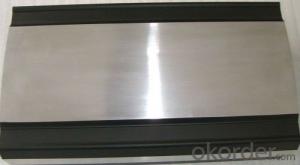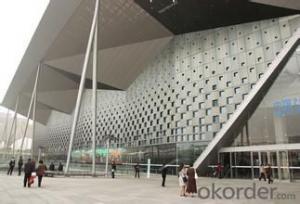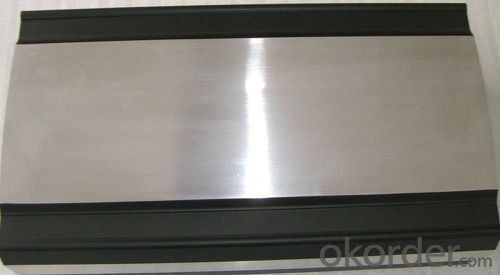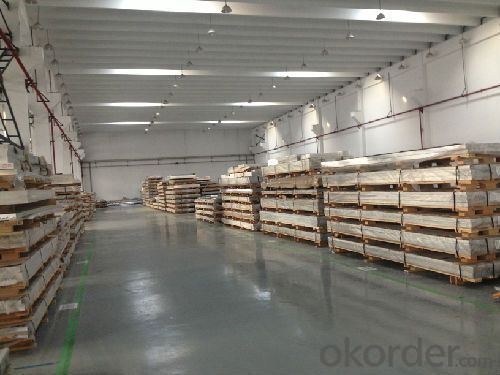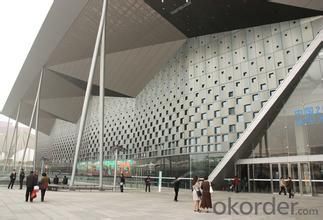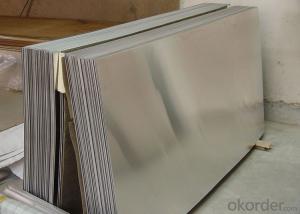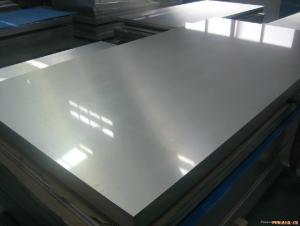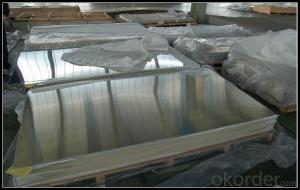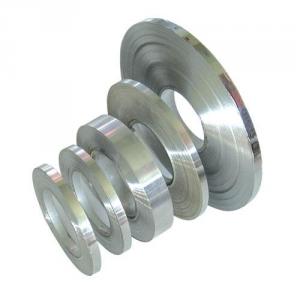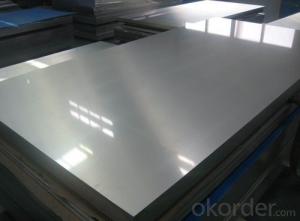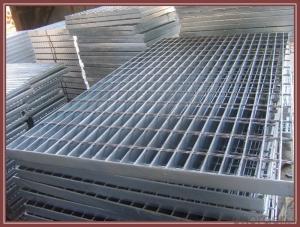Series 5 Aluminum Hydroxide Sheets for Track Transportation
- Loading Port:
- Shanghai
- Payment Terms:
- TT OR LC
- Min Order Qty:
- 5 m.t.
- Supply Capability:
- 9000 m.t./month
OKorder Service Pledge
OKorder Financial Service
You Might Also Like
Specification
1. Specification
| Alloy | Temper | Gauge(mm) | ||
5000 series
| H32/H34/H116/H321H113/O/T4/T6/T651 | Thickness | Width | Length |
| 0.2-80 | 1000-2600 | 1000-16500 | ||
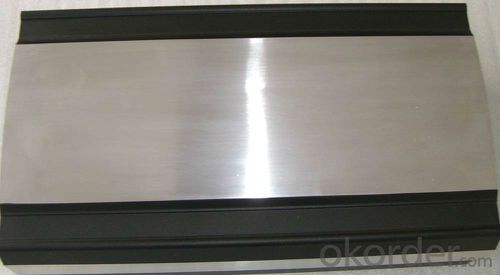
2. Production Feature
Wide,produced by widest 1+4 hot rolling line in China
Long, performance sustainable even after forming
Rust & erosion resistant
Well shaped,
Good surface
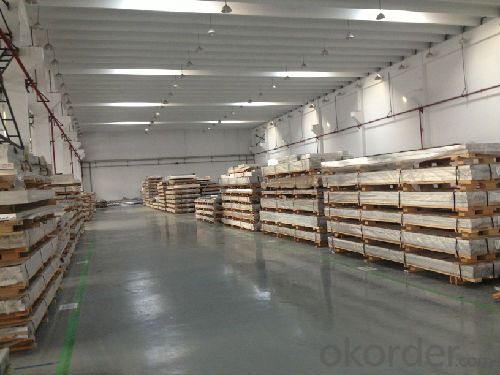
3. Packing & Shipping
Wooden pallet and steel band packing
Eye to sky & eye to wall
Shipped in 20ft & 40ft containers
4. Product Standard
ASTM- B 209
EN485
GB3880.3-2012
JIS4000
5. Application
Products are widely used in wide range transportation, packing & printing, mechanical manufacturing, electronic communication, hardware molding, architectural decoration and etc.

- Q: What are the different forms of aluminum sheet available?
- There are several different forms of aluminum sheet available, including plain, embossed, perforated, and painted aluminum sheets.
- Q: What are the different alloys available for aluminum sheets?
- There are several different alloys available for aluminum sheets, each with its own unique properties and applications. Some of the most common alloys include: 1. 1100: This is a commercially pure aluminum alloy with excellent corrosion resistance, making it suitable for applications where high levels of corrosion resistance are required, such as in marine environments. 2. 3003: Another commercially pure alloy, 3003 offers good formability, high corrosion resistance, and moderate strength. It is commonly used for general sheet metal work, cooking utensils, and chemical equipment. 3. 5052: This alloy is known for its high fatigue strength and excellent corrosion resistance, particularly in saltwater environments. It is often used in marine applications, as well as for aircraft components and fuel tanks. 4. 6061: A heat-treatable alloy, 6061 exhibits good weldability and formability, along with high strength and excellent corrosion resistance. It is commonly used in structural components, such as frames and railings, as well as automotive parts. 5. 7075: This alloy is known for its high strength-to-weight ratio, making it ideal for aerospace applications and high-stress structural components. However, it is less corrosion resistant than other alloys and may require protective coatings in certain environments. These are just a few examples of the alloys available for aluminum sheets. The choice of alloy will depend on the specific requirements of the application, such as strength, corrosion resistance, formability, and cost. It is important to consult with a knowledgeable supplier or engineer to determine the most suitable alloy for your specific needs.
- Q: Can 101 aluminum sheets be used in HVAC systems?
- Yes, 101 aluminum sheets can be used in HVAC systems.
- Q: What are the different types of alloys used for painted aluminum sheets?
- Painted aluminum sheets commonly utilize various types of alloys. Among them, 3003 stands out as a favored option due to its exceptional corrosion resistance and high formability. This alloy finds extensive use in industries like automotive, where a smooth surface finish is preferred. Another frequently employed alloy is 5052, which provides superior strength compared to 3003. Its remarkable resistance to corrosion and ability to endure harsh environments make it suitable for marine and architectural applications. Moreover, it is renowned for its weldability and formability. 6061 is also a well-liked choice for painted aluminum sheets. Its notable attributes include high strength and excellent machinability. This alloy is often employed in structural applications, such as the production of aircraft parts and automotive components. Furthermore, painted aluminum sheets may incorporate other alloys like 2024, 5754, and 7075. These alloys possess specific properties that render them suitable for particular applications, such as elevated strength or improved corrosion resistance. In essence, the selection of the alloy for painted aluminum sheets hinges upon the specific requirements of the application, such as desired strength, corrosion resistance, and formability.
- Q: Are aluminum sheets suitable for use in HVAC (heating, ventilation, and air conditioning) systems?
- Yes, aluminum sheets are suitable for use in HVAC systems. Aluminum is a popular material choice for HVAC systems due to its various beneficial properties. Firstly, aluminum is lightweight yet strong, making it easy to handle and install in HVAC systems. Its low density also allows for cost-effective transportation and reduces the overall weight of the HVAC units. Secondly, aluminum has excellent corrosion resistance. HVAC systems often encounter moisture and condensation, especially in air conditioning units, and aluminum's resistance to corrosion ensures its durability and longevity in such environments. Additionally, aluminum sheets have good thermal conductivity, allowing for efficient heat transfer throughout the HVAC system. This property is particularly important in heating and cooling applications, as it helps to distribute the desired temperature effectively. Moreover, aluminum is a non-toxic material, making it safe for use in HVAC systems that circulate air throughout buildings. It does not release any harmful particles or gases into the air, ensuring the quality of indoor air. Lastly, aluminum is a highly recyclable material, making it environmentally friendly. The ability to recycle aluminum sheets reduces the carbon footprint associated with HVAC systems and aligns with sustainability goals. Considering all these advantages, aluminum sheets are indeed suitable for use in HVAC systems, providing an optimal balance of strength, corrosion resistance, thermal conductivity, safety, and environmental friendliness.
- Q: What safety measures should be taken into account when installing aluminum sheets?
- <p>When installing aluminum sheets, it's important to follow safety precautions. Always wear appropriate personal protective equipment, including gloves and safety glasses. Ensure the work area is clear of debris and other hazards. Use the correct tools for cutting and handling aluminum sheets to prevent injuries. Be cautious of sharp edges and corners that can cause cuts. Ensure the aluminum sheets are properly secured to avoid them falling and causing harm. Follow all manufacturer guidelines for installation to ensure the stability and longevity of the aluminum sheets.</p>
- Q: What are the potential safety issues that may arise from the use of aluminum sheets?
- <p>Aluminum sheets are generally safe to use in most applications. However, there are a few safety concerns to consider. First, aluminum can be a skin irritant for some individuals, so it's important to wear protective gloves when handling. Second, aluminum dust, when inhaled, can cause respiratory issues. Proper ventilation should be maintained during cutting or grinding operations. Lastly, aluminum can conduct electricity, so it should not be used in electrical applications without proper insulation. Always follow safety guidelines and use protective equipment when working with aluminum sheets to minimize these risks.</p>
- Q: What are the fire-resistant properties of aluminum sheets?
- Aluminum sheets have excellent fire-resistant properties due to their high melting point, which is around 660°C (1220°F). They do not burn or release any harmful gases when exposed to fire. Additionally, the oxide layer that forms naturally on the surface of aluminum provides further protection against fire by acting as a barrier that prevents the metal from direct contact with flames.
- Q: What are the different bending techniques for aluminum sheets?
- Aluminum sheets can be bent using various techniques. Some commonly used techniques include: 1. Air bending: By applying force with a punch, the sheet bends in a straight line. The degree of bending depends on the force exerted. 2. Bottom bending: In this method, the sheet is clamped between a bottom tool and a die. A punch is then used to apply force from the top, resulting in a precise and consistent bend angle. 3. Coining: This technique involves bending the sheet with a punch and die, but with significantly higher force compared to other methods. The result is a crisp and sharp bend with minimal springback. 4. Rotary bending: The sheet is gradually bent around a rotating bending roll, which applies pressure to achieve a smooth bend. 5. Roll bending: Large sheets or cylindrical shapes are formed by passing the aluminum sheet through a series of rollers that gradually bend it to the desired shape. 6. Press braking: A versatile technique that utilizes a press brake machine consisting of a punch, die, and back gauge. This allows for precise and repeatable bends. Each technique has its own advantages and limitations, and the choice depends on factors like the desired bend angle, sheet thickness, and final product shape. It is crucial to select the appropriate technique to achieve the desired result and prevent any defects or damage to the aluminum sheet.
- Q: Is it possible to apply paint to an aluminum sheet roof after it has been installed?
- <p>Yes, you can paint your aluminum sheet roof after installation. However, it's crucial to ensure the surface is clean and free of any contaminants. Use a primer specifically designed for aluminum to enhance adhesion and durability. Apply a high-quality paint suitable for metal surfaces, following the manufacturer's instructions carefully. This process can help protect the roof from weathering and enhance its appearance, but it's recommended to consult with a professional to ensure the best results and longevity of the paint job.</p>
Send your message to us
Series 5 Aluminum Hydroxide Sheets for Track Transportation
- Loading Port:
- Shanghai
- Payment Terms:
- TT OR LC
- Min Order Qty:
- 5 m.t.
- Supply Capability:
- 9000 m.t./month
OKorder Service Pledge
OKorder Financial Service
Similar products
Hot products
Hot Searches
Related keywords
